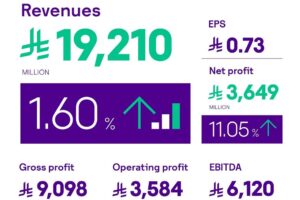etisalat by e& has announced the first commercial deployment of comprehensive 5G Stand-Alone (SA) network in the Middle East and North Africa (MENA) for consumers and businesses. This marks a significant improvement over the previous generation of 5G Non Stand Alone (NSA) currently available in the market. etisalat by e& first launched the previous generation of 5G NSA commercially in 2018, which was the first of its kind in the region. With this deployment, etisalat by e& has transitioned from using a 5G radio access network on an existing 4G LTE network to a more advanced 5G network.
The latest version of the 5G network will provide customers with access to a dependable nationwide standalone network that can support a wide range of applications. These applications include massive machine-to-machine communication solutions, real-time device-to-device networking, ultra-reliable, low-latency functionality for autonomous devices and next-generation Internet of Things (IoT) devices. Standalone 5G technology offers additional capacity and significantly lower latency, making it essential for innovative use cases such as Industry 4.0, industrial IoT, commercial augmented and virtual reality, and large-scale digital sensing.
The etisalat by E& 5G Stand Alone (SA) service is designed to offer a more satisfying and productive user experience. Users can enjoy high-speed broadband connectivity comparable to fibre-optic connections, which provides an enhanced experience for high-demand applications such as 4K video streaming, high-quality music streaming, and cloud gaming. In addition to providing individuals with a more efficient broadband experience, the service can also serve as an alternative broadband option for businesses. By leveraging the advantages of 5G SA Fixed Wireless Access (FWA), companies can improve their operations and customer experience.
Khalid Murshed, Chief Technology & Information Officer of etisalat by e&, said: “We are pleased to announce our successful investment in 5G Standalone technology. This is a significant milestone as we look to deliver end-to-end 5G solutions in UAE, providing our customers with the latest digital innovations and superior experience and laying the foundation for new revenue streams. The 5G Standalone network will allow us to offer our customers the latest in high-speed and low-latency connectivity. Our recent collaborations have enabled us to increase the quality of our services, while creating a more reliable and cost-effective experience for our customers. We are proud to be leading the way in 5G technology and are committed to continuing our efforts to provide the best services in the industry.”
This commercial deployment of a comprehensive 5G Stand-Alone network is based on Service Based Architecture (SBA), including the capability of edge computing, network slicing, 3GPP SA (defining standard for 5G) guided network orchestration and service-based architecture. Launching the 5G Stand-Alone Fixed Wireless Access (5G SA FWA) as the first service will open a new era of commercial use cases with a multi-vendor 5G Dual Mode network to enhance the broadband offering to customers.
The technology of 5G SA will enable subscribers to enjoy higher uplink bandwidth with special case scenarios for enterprise applications where uplink throughput is equally important as downlink. In other cases, requiring lower user-traffic latency, it will address critical gaming issues and experience futuristic technologies like Virtual Reality (VR) and cloud gaming. The technology also has high-security levels that utilise best industry practices to maintain a robust network.
The solution is further enriched with network exposure, slicing, edge computing and orchestration. Network slicing is a way of virtualising the 5G network, allowing it to be partitioned into multiple, logically isolated networks for different customers based on their needs. It allows for greater efficiency and flexibility in the deployment of 5G networks. Edge computing is a way of bringing computing resources closer to the users, reducing latency and improving the performance of applications. The 5G SA will co-exist efficiently with existing networks using dual-mode 5G core technology.












